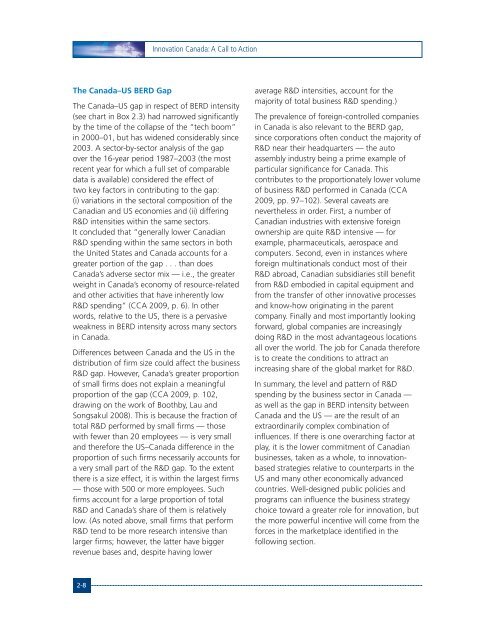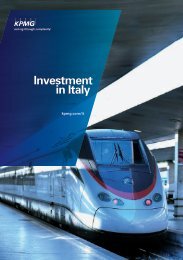Innovation Canada: A Call to Action
Innovation Canada: A Call to Action
Innovation Canada: A Call to Action
You also want an ePaper? Increase the reach of your titles
YUMPU automatically turns print PDFs into web optimized ePapers that Google loves.
<strong>Innovation</strong> <strong>Canada</strong>: A <strong>Call</strong> <strong>to</strong> <strong>Action</strong>The <strong>Canada</strong>–US BERD GapThe <strong>Canada</strong>–US gap in respect of BERD intensity(see chart in Box 2.3) had narrowed significantlyby the time of the collapse of the “tech boom”in 2000–01, but has widened considerably since2003. A sec<strong>to</strong>r-by-sec<strong>to</strong>r analysis of the gapover the 16-year period 1987–2003 (the mostrecent year for which a full set of comparabledata is available) considered the effect oftwo key fac<strong>to</strong>rs in contributing <strong>to</strong> the gap:(i) variations in the sec<strong>to</strong>ral composition of theCanadian and US economies and (ii) differingR&D intensities within the same sec<strong>to</strong>rs.It concluded that “generally lower CanadianR&D spending within the same sec<strong>to</strong>rs in boththe United States and <strong>Canada</strong> accounts for agreater portion of the gap . . . than does<strong>Canada</strong>’s adverse sec<strong>to</strong>r mix — i.e., the greaterweight in <strong>Canada</strong>’s economy of resource-relatedand other activities that have inherently lowR&D spending” (CCA 2009, p. 6). In otherwords, relative <strong>to</strong> the US, there is a pervasiveweakness in BERD intensity across many sec<strong>to</strong>rsin <strong>Canada</strong>.Differences between <strong>Canada</strong> and the US in thedistribution of firm size could affect the businessR&D gap. However, <strong>Canada</strong>’s greater proportionof small firms does not explain a meaningfulproportion of the gap (CCA 2009, p. 102,drawing on the work of Boothby, Lau andSongsakul 2008). This is because the fraction of<strong>to</strong>tal R&D performed by small firms — thosewith fewer than 20 employees — is very smalland therefore the US–<strong>Canada</strong> difference in theproportion of such firms necessarily accounts fora very small part of the R&D gap. To the extentthere is a size effect, it is within the largest firms— those with 500 or more employees. Suchfirms account for a large proportion of <strong>to</strong>talR&D and <strong>Canada</strong>’s share of them is relativelylow. (As noted above, small firms that performR&D tend <strong>to</strong> be more research intensive thanlarger firms; however, the latter have biggerrevenue bases and, despite having loweraverage R&D intensities, account for themajority of <strong>to</strong>tal business R&D spending.)The prevalence of foreign-controlled companiesin <strong>Canada</strong> is also relevant <strong>to</strong> the BERD gap,since corporations often conduct the majority ofR&D near their headquarters — the au<strong>to</strong>assembly industry being a prime example ofparticular significance for <strong>Canada</strong>. Thiscontributes <strong>to</strong> the proportionately lower volumeof business R&D performed in <strong>Canada</strong> (CCA2009, pp. 97–102). Several caveats arenevertheless in order. First, a number ofCanadian industries with extensive foreignownership are quite R&D intensive — forexample, pharmaceuticals, aerospace andcomputers. Second, even in instances whereforeign multinationals conduct most of theirR&D abroad, Canadian subsidiaries still benefitfrom R&D embodied in capital equipment andfrom the transfer of other innovative processesand know-how originating in the parentcompany. Finally and most importantly lookingforward, global companies are increasinglydoing R&D in the most advantageous locationsall over the world. The job for <strong>Canada</strong> thereforeis <strong>to</strong> create the conditions <strong>to</strong> attract anincreasing share of the global market for R&D.In summary, the level and pattern of R&Dspending by the business sec<strong>to</strong>r in <strong>Canada</strong> —as well as the gap in BERD intensity between<strong>Canada</strong> and the US — are the result of anextraordinarily complex combination ofinfluences. If there is one overarching fac<strong>to</strong>r atplay, it is the lower commitment of Canadianbusinesses, taken as a whole, <strong>to</strong> innovationbasedstrategies relative <strong>to</strong> counterparts in theUS and many other economically advancedcountries. Well-designed public policies andprograms can influence the business strategychoice <strong>to</strong>ward a greater role for innovation, butthe more powerful incentive will come from theforces in the marketplace identified in thefollowing section.2-8
















